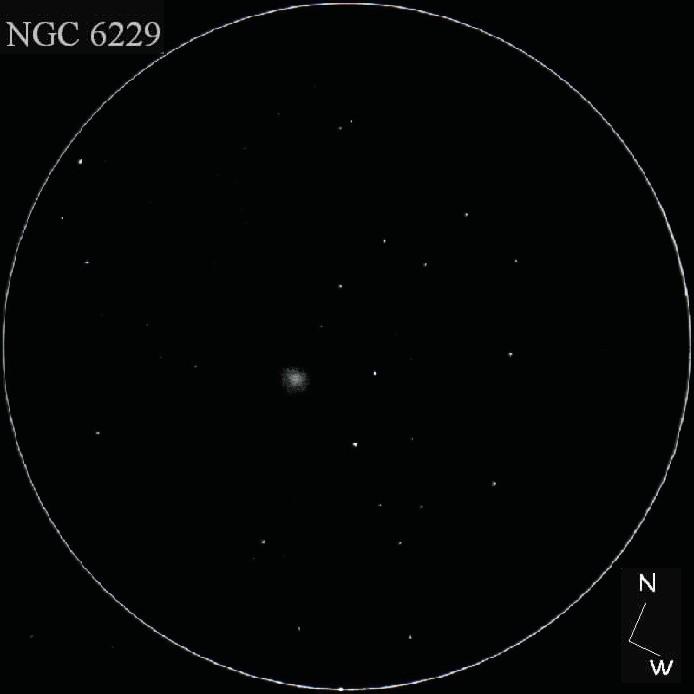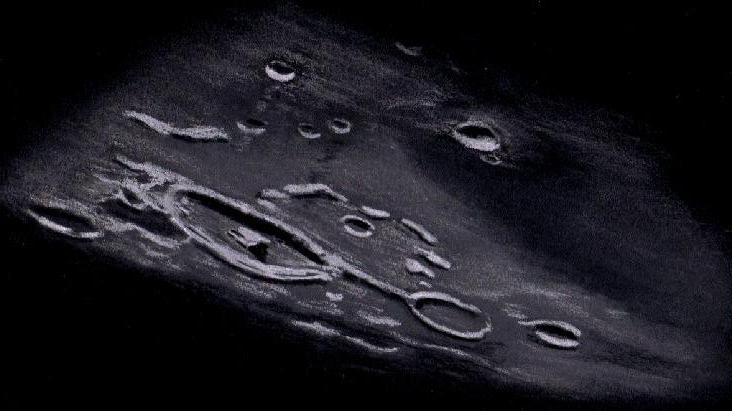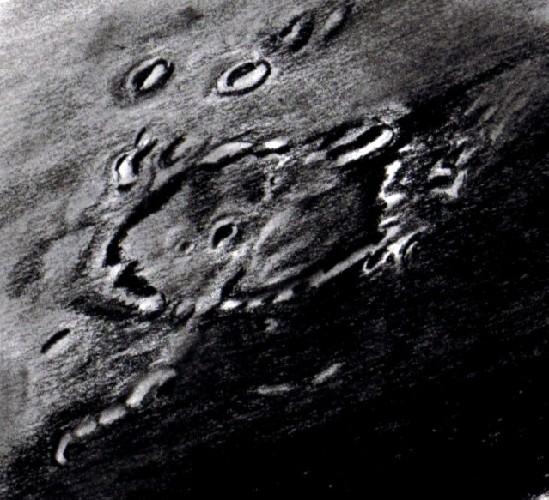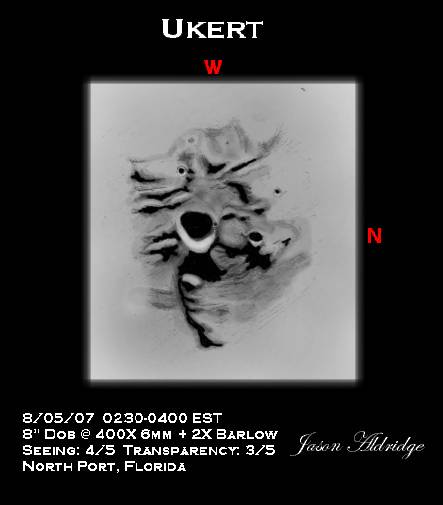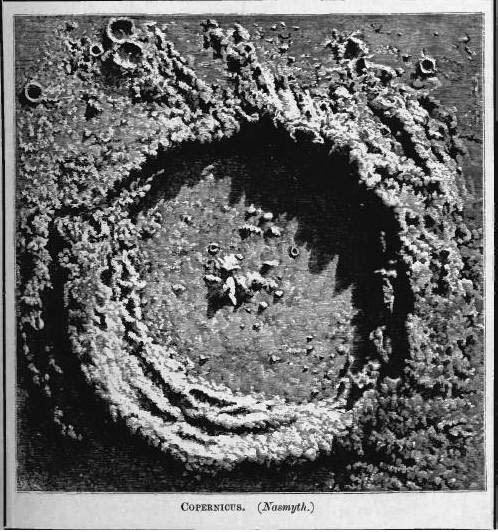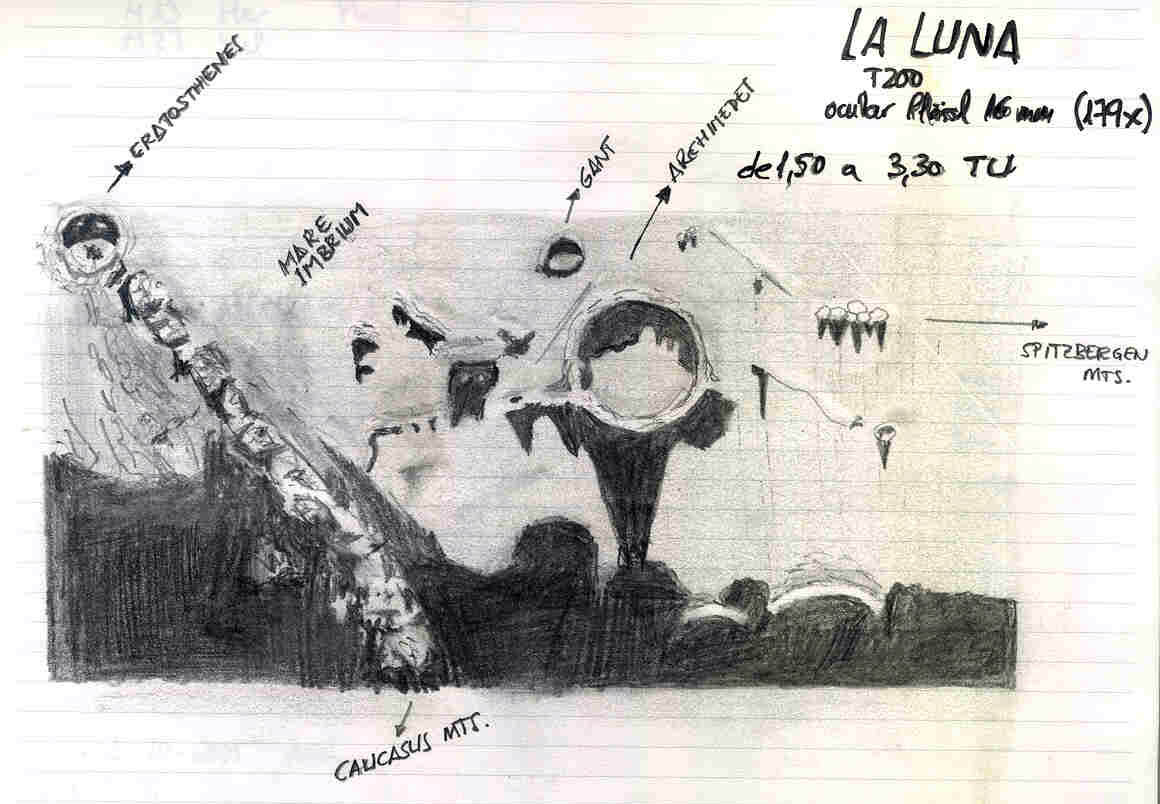Large globular clusters are always rewarding targets to hunt down from less than
ideal sky locations. In a 10” telescope from urban/suburban locations only the 9th
magnitude glow of this globular is clearly visible. Upon closer inspection the
core can be seen to brighten significantly. The angular size of this cluster looks
to be about 1.5 minutes of arc in the eyepiece. It is easy to see why 18th and
19th century observers thought this globular to be a planetary and on at least one
occasion it was reported to be a comet. At almost 100,000 light years distant, it
is challenging to resolve stars in this globular without at least 13 inches of
aperture. I could not resolve any stars of the cluster with the 10” scope. The
brightest stars in this globular cluster are about magnitude 15.5. Adding to the
eyepiece view are two well spaced 8th magnitude stars to the west listed in the
Henry Draper catalog as HD151689 and HD 151651.
Sketching Date and Time: 8-12-2007, 2:30-2:50 UT
Telescope 10” f / 5.7 Dobsonian 21mm eyepiece 69x
8”x12” white sketching paper, B and 4B graphite pencils, a blending stump, scanned
and inverted
Seeing: Pickering 7/10
Transparency: average 2.5/5
NELM 4.1
Frank McCabe
Author: richardhandy
The wind and Aristoteles
It was a very clear and transparent night when I finally got my shot at drawing the
lunar crater, Aristoteles. Unfortunately, there was a steady 17-20 MPH wind that
shook my little 8″ Dob, and caused my subject to jump around in the eyepiece. I
managed to capture this magnificent crater during the brief periods of calm, so I
apologize for any inaccuracies.
This sketch was rendered on Strathmore Windpower Sketch paper with a .5mm 2HB
mechanical pencil. MGI Photosuite III was used for post processing.
Jason Aldridge
North Port, Florida
Pythagoras on the Moon
It was approaching the time for sunset and Venus was not visible in the west through the clouds. To the southeast the glow of the moon behind the clouds and haze was just visible and it was not shaping up very well for an observing night. As twilight ended and the moon continued rising, it began to look like an observing session could happen. The moon was yellow-orange in color through the haze and not quite 25° above the southern horizon when I began to sketch Pythagoras crater at the northern terminator region. Although the transparency was so poor 3rd magnitude stars were not visible overhead, the seeing was above average. Along the terminator 130 km. crater Pythagoras with its twin tall central peaks and brightly illuminated, terraced northwestern wall was nicely visible. Hugging the southern wall of Pythagoras, slightly larger Babbage (140 km.) with its crumbled walls and large central crater Babbage A shared the spotlight near the dark lavas of Mare Frigoris. Following the west wall of Babbage to the south the 70 km. crater Oenopides stood out with its relatively smooth looking flat floor. And finally standing somewhat alone in the dark lavas is rayed crater Harpalus (41 km.) the youngest of the named craters in the sketch.
Sketching:
For this sketch I used: black Strathmore 400 Artagain paper, white and black Conte’
pastel pencils and a blending stump. Contrast was slightly increased after scanning.
Telescope: 10 inch f/ 5.7 Dobsonian and 9 mm eyepiece 161X
Date: 5-30-2007 2:42-3:30 UT
Temperature: 24° C (75° F)
Partly cloudy with much haze, calm
Seeing: Antoniadi II-III
Colongitude 70.4 °
Lunation 13.3 days
Illumination 97 %
Frank McCabe
Great Globular
Astronomy, wildflowers and photography
Lunar Crater J Herschel
The sun was rising across the 165 km wide irregular floor of this walled plain
crater at the time of this observation. J Herschel is a pre-Nectarian crater and
in the observing light was showing off a low inner rim, secondary craters, and
rubbly, slightly convex floor. With the Imbrium basin formation taking place a
couple of hundred million years after J Herschel, it is easy to see why this
crater looks so old and battered. The well defined outer rim to the south (up in
the sketch) has its rampart buried under the lavas of Mare Frigoris. Also the mare
looks to be at a slightly higher elevation than the crater floor on the other side
of the wall. Along the south wall to the west crater Horrebow (26 km) can be seen
superimposed upon Horrebow A. Out into Mare Frigoris a couple of dozen kilometers
are craters La Condamine B and J Herschel F both slightly under 20 km in diameter.
Sketching:
For this sketch I used: White CCP sketching paper, 2 HB graphite pencil and a black
ink pen. Contrast and brightness were adjusted after scanning.
Telescope: 10 inch f/ 5.7 Dobsonian and 6 mm eyepiece 241X
Date: 5-28-2007 1:01-1:40 UT
Temperature: 16° C (60° F)
Partly cloudy with haze, calm
Seeing: Antoniadi III
Colongitude 45.1 °
Lunation 11 days
Illumination 85.8 %
Frank McCabe
A fine and Royal bird
The window of opportunity to explore the treasures of Sagittarius
is fairly brief from my 52 degree latitude observatory. This
coupled with the fact that my southern horizon looks towards the
closest town 2 miles away with the sprawl of London starting just
25miles further on make for challenging observing especially of
diffuse objects.
M17 the Swan or Check Mark nebula is one of the objects which I can get good views
of and one that visitors to my optics agree matches well with its name.
Last week I caught up with this fine and Royal bird swimming on its stellar river.
The view prompted me to dig out this sketch from a couple of seasons back to share
with others.
Scope used 14″ F5 Newtonian at 77x UHC Lumicon filter.HB pencil & blending stump
on white cartridge paper, scanned and saved as a negative with no enhancement.
From the Chippingdale Observatory, Hertfordshire, England.
Clear Skies, Dale
Between the middle bay and a sea of vapors
Ukert is a relatively small crater that lies between Sinus Medii and Mare Vaporum. I
found it’s surrounding environment to be quite fascinating which is why I chose it
for the subject of this sketch. It was rendered on Strathmore Windpower sketch paper
with a 2HB mechanical pencil. Post processing was done with MGI Photosuite III.
Jason Aldridge
North Port, Florida
An Inventor and Lunar Sketcher of the mid-Nineteenth Century
The sketch of Copernicus crater shown above was made by James Nasmyth and is from
George F. Chambers’ book, A Handbook of Descriptive and Practical Astronomy,
1889-1890, Oxford, Clarendon, vol.1, figure 65 page 129.
James Nasmyth will always be remembered for his ability to invent, design and
improve on power tools. Born in Edinburgh, Scotland in 1808 to an artist father,
he left school at an early age to build machines, a passion that became his
vocation. His most famous invention was a forerunner to the pile driver known as
the steam hammer. With a life long interest in astronomy he spent the last 30 of
his 81 year lifespan directly involved in astronomy. During this time he built
telescopes and improved their mounts. In addition he charted and drew the moon and
sketched sunspots.
This quote from the above work appears on page 128 and is associated with the
Copernicus crater drawing above. It is most revealing of 19th century thought
about lunar crater origin. “The Volcanic origin of the lunar craters cannot be
more plainly demonstrated than by comparing an engraving such as Fig.62, which
represents a known volcano – Tenerife- with any good engraving of a lunar crater,
e.g. Copernicus, Fig.65. The similarity is too striking to admit of there being
any doubts as to the identity of the physical causes which have originated each
surface.”
Frank McCabe

